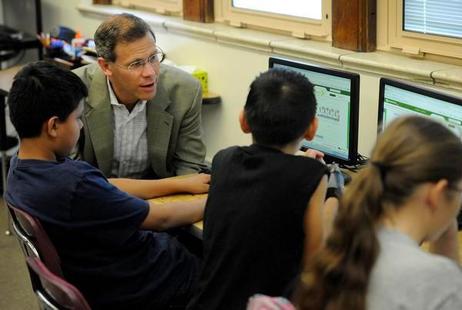As public schools embrace technology's evolving availability and convenience, many high schools are implementing online courses to cater to more students. Â鶹ąű¶ł´«Ă˝ly, researchers from Harvard suggest that “while only about 1 percent of courses in 2007 were online, this figure represents a 22-fold increase from 2000 and should grow to 10 percent within six years and to about 50 percent by 2019.”
Furthermore, as the public policy research center at Stanford University projects, the rising affordability of technology may result in nearly half of all high school courses being available online.
In this enlightening article, we delve into the realm of online learning and its growing significance in public high schools. We explore the diverse range of online learning opportunities available to high school students, including virtual classrooms, interactive coursework, and digital resources. From advanced placement (AP) courses to specialized electives and credit recovery programs, online learning offers flexibility, personalized instruction, and expanded educational horizons. We discuss the benefits and challenges of online learning, highlighting its potential to foster self-directed learning, enhance digital literacy, and accommodate diverse learning styles. Furthermore, we examine the strategies public high schools employ to implement and integrate online learning effectively while addressing equity concerns and ensuring student success. Join us as we navigate the world of online learning in public high schools and uncover the transformative potential it holds for students seeking innovative educational opportunities.
This video explains how and why high schools are using online learning.
Why are Schools Offering Online Learning Opportunities?
As technology is ever-changing, it impacts how public schools teach and students learn. As The National Education Association (NEA) explains, “Barriers of time and place are tumbling as technology offers new choices and opportunities for students and educators. Over the last 20 years or more, American schools have embraced distance learning tools to enhance students' educational opportunities.”
With the implementation of new technologies, schools have taken advantage of the latest multimedia teaching strategies, Internet-based projects for students, and, most recently, the opportunities for distance learning. Considering that nearly all public schools have internet access, more schools across the country are including online classes in their curriculum.
What is the Appeal of Online Learning?
A Broad Curriculum
For public schools, the appeal of online courses is usually twofold: it decreases the costs and increases the course offerings. As the NEA describes, “The appeal of online courses is evident: they can increase the range of course offerings available to all students as well as provide educational access to special students (for example, homebound, incarcerated, and atypical students for whom regular classrooms are not effective).” Along with a broader curriculum, schools are more able to provide diverse and alternative instructional methods.
Cost Benefits
When public schools provide students with online courses, they are saving often large sums of money because of class sizes. Today, high school classes often cost the district $600 per course, whereas online courses only cost around $200 per course. Since schools do not have to pay for as many instructors because more students can be enrolled in a single online class, they save money on instructional costs and building / environmental costs. Some high schools have even pushed for a fully online summer program so that energy and money are not spent on keeping the school building running, yet classes and educational needs can still be met.
This video offers insights into how students feel about online learning.
Additional Benefits and Goals
While online learning is becoming a realistic and beneficial option for both schools and students, the NEA asserts, "Today's challenge is to ensure that information technology increases the number of educational opportunities while maintaining or enhancing the quality of those opportunities.” In looking to better serve students, schools are also appreciating that online courses provide more customized instruction, increased remediation, continuing education for dropouts, and additional support for home-schooled or homebound students.
Ultimately, as research from Harvard supports, the majority of the American public “favors online education,” as approximately sixty-nine percent of all polled parents stated that they would allow their children to take online courses for credit.
Where are the Online Learning Opportunities?
As the explains, online learning is mostly occurring at high school levels, as the standards of 9-12 courses may be easier to uphold. High school and higher education courses “have a longer track record and a different set of purposes, administrative practices, and audiences.” With this, high school students face a diverse set of challenges; therefore, online courses must still “address the unique social, educational, and emotional needs of high school students.”
Since the high school environment still actively works to educate children both academically and socially, the NEA asserts that there only a few online courses should be taken by each student; if online courses become the bulk of a student’s education, then social and communicative issues may arise for some teens, as the NEA further explains, online courses may raise “a series of difficult questions (of) the appropriateness of online education for younger students.”
Furthermore, the NEA asserts that since high school teens can handle the varying learning experiences from the classroom to the online learning setting, the organization explains: “Our current understanding of the characteristics and needs of learners in earlier grades, however, would suggest we exercise great caution in the use of the online environment to deliver instruction to students prior to middle school.”
Are Online Courses Available at My Child’s High School?
As each public school offers different programs and opportunities, you can check your child’s school’s website or county/district offices to find out if online courses are available.
Also, school counselors are a great resource for discussing if online learning is appropriate for your teen, as they can also inform you about the details of potentially available online courses. Paired with this, if your child is seeking college credit, counselors can often assist you in enrolling in community college online courses that may also contribute to your child’s high school transcripts and records. As each public school's standards and regulations vary, counselors, advisors, and teachers will be your greatest source of assistance and information.
Questions? Contacts us on Facebook.. @publicschoolreview















